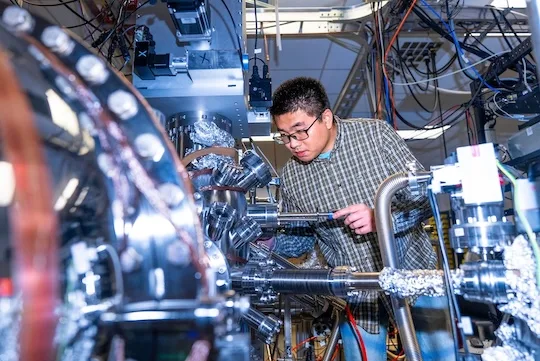Physicists at Rice University have discovered a phase-changing quantum material that could be used to create flash-like memory for storing quantum bits of information, or qubits. The team, led by physicist Ming Yi, used heat to toggle a crystal of iron, germanium, and tellurium between two electronic phases. The discovery could potentially reduce errors in quantum computing.
The study, published in Nature Communications, involved collaboration with over a dozen institutions. The Department of Energy, the Gordon and Betty Moore Foundation, the Robert A. Welch Foundation, and others supported the research.
Discovery of Phase-Changing Quantum Material
Rice University physicists have identified a phase-changing quantum material that could potentially be used to create nonvolatile memory capable of storing quantum bits of information, or qubits, even when a quantum computer is powered down. This discovery, along with a method for finding more such materials, could accelerate the development of nonvolatile quantum memory.
Phase-changing materials have been used in commercially available nonvolatile digital memory, such as rewritable DVDs. In these devices, a laser is used to heat minute bits of material that cools to form either crystals or amorphous clumps. Two phases of the material, which have very different optical properties, are used to store the ones and zeros of digital bits of information.
Heat-Induced Phase Change in Quantum Material
The team of physicists from Rice University and collaborating institutions discovered a method to use heat to switch crystals of iron, germanium, and tellurium between two topological phases where qubits could potentially be stored. The researchers demonstrated that empty atomic sites in the crystals’ lattice, known as vacancies, were arranged in differently ordered patterns depending on how quickly the crystal cooled.
The researchers found that they could switch phases on and off by reheating crystals and allowing them to cool for either longer or shorter periods of time. The result is a change in the crystalline symmetry that dictates the electronic topology. This discovery was unexpected and took more than two years and collaborative work with dozens of colleagues to decipher.
Vacancy Order and Topological Properties
Unlike the materials used in most phase-changing memory technology, the iron-germanium-tellurium alloy did not need to be melted and recrystallized to change phases. The researchers found that changes in vacancy order change the lattice symmetry, which can change the electronic topology.
The idea of using vacancy order to control topology is a novel concept. Typically, studies have only looked at materials from a fully stoichiometric perspective, meaning everything’s occupied with a fixed set of symmetries that lead to one kind of electronic topology. This work shows how changes in vacancy order can induce topological changes in other materials as well.
Implications for Quantum Computing
The discovery of a phase-changing quantum material that could potentially be used to create nonvolatile memory capable of storing qubits has significant implications for quantum computing. Storing qubits in topologically protected states could potentially reduce decoherence-related errors that have plagued quantum computing.
The ability to arrange a change of crystalline symmetry on the fly enables a completely unexpected and yet fully welcoming switching capacity for theory as well as we seek to design and control new forms of topology through the cooperation of strong correlations and space group symmetry.
External Link: Click Here For More

